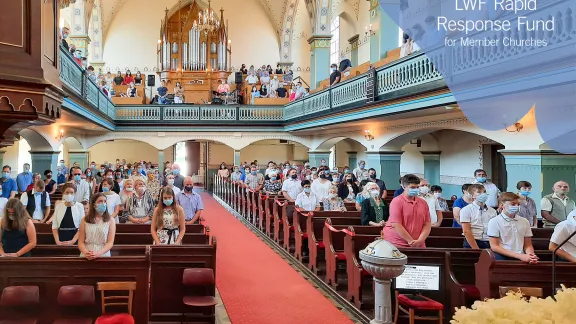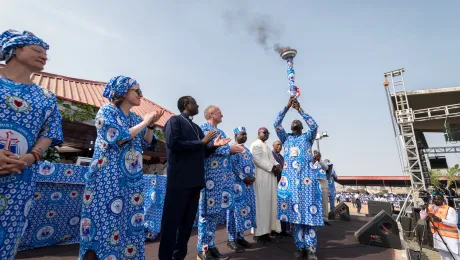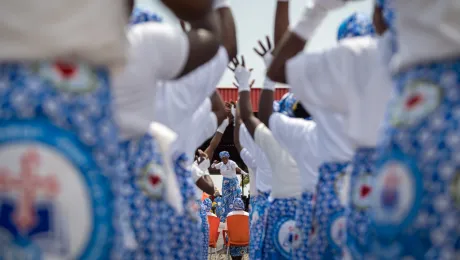
On 12 July, a confirmation service was held in Murska Sobota, observing the distancing and other rules. Photo: ECS
Rapid Response Fund: Evangelical Church of the Augsburg Confession in Slovenia uses more technical facilities in church life and worship
(LWI) – How can we stay in contact with one another despite the restrictions imposed during the Coronavirus disease (COVID-19) pandemic? How can we approach and encourage people in a time of anxiety and uncertainty? – The Evangelical Church of the Augsburg Confession in Slovenia, a member church of the Lutheran World Federation (LWF) in the Central Eastern Europe Region, found that one reply to these questions was increased use of digital media and television.
Slovenia has so far had relatively few COVID-19 cases. But the measures taken to protect the population have drastic effects on life in society – also on the churches.
We started looking for new ways of contacting the members of our congregations and also others outside the church.
“In mid-March, we had to close down all worship services, religious education, and confirmation classes as well as occasional offices except for funerals,” reports Bishop Leon Novak. “We started looking for new ways of contacting the members of our congregations and also others outside the church.”
Television and digital media
The bishop’s first conclusion about these efforts is encouraging: “We were able to use modern digital media to contact younger and middle-aged people,” Novak says. “The regional TV program is more effective for reaching the older generation, who don’t have a computer or internet connection.”
That was a way of enabling the risk group, particularly in retirement homes or hospitals to participate in a church service, since all hospital rooms and retirement homes have TV sets. “With our programs we also addressed and reached single people or risk groups isolated from their family members and relatives,” Novak adds.
Services of worship were recorded and then transmitted via the social media and the regional television broadcaster TV Idea. “In the social media, we posted short, thematic video clips inviting people to the worship service, and it worked very well,” Novak reports. “That way, we reached a lot of people, which is very encouraging for us. We want to build on this approach to invite young people and those with no church connection.”
As many church members continue to avoid attending public events – including worship services – the Slovenian church will continue to rely on these technical formats.
“Since mid-May, we are allowed to hold services again but only with special hygiene rules,” Novak says.
Technical aids are helpful here too: all the hymns, prayers, readings, and announcements are presented on a big TV screen in the church. Thus, there is no need for hymn books or Bibles through which worshippers could be infected. “The congregation received this format very well,” says Novak.
The costs for the technical equipment, video, and audio recordings and transmission were covered thanks to the LWF’s COVID-19 Rapid Response Fund and the financial support from the German National Committee of the Lutheran World Federation (GNC/LWF).
Concern about financing clergy salaries
Nevertheless, the bishop has reason for concern. “Owing to the social distancing measures in the course of the coronavirus pandemic, the Evangelical Church in Slovenia has lost a lot of donations as parishioners were unable to attend church services. It has been the tradition for church contributions to be delivered personally to parsonages or parish offices.”
This practice has many positive effects: “Pastors have had personal contact with the members of their parishes and an opportunity for a conversation.” Through the pandemic, this procedure has become a severe problem. “For three months, there have been very few payments, if any, which confronts the church with a serious financial challenge. Given this trend and due to the consequences of the loss of church contributions, it is going to be a problem to pay pastors’ salaries in late autumn,” Novak reports. “We are continually looking for solutions. But the loss of many jobs through the pandemic is a major problem – that also affects our church members.”
Now the church is aiming to change its system: in the future, the church contribution is to be paid by bank transfer. “This way, we hope to be able to collect 70 to 80 percent of the contributions within three to four years,” Novak says. That would make the financing channels less vulnerable to a crisis if there were to be another pandemic.
The Rapid Response Fund, launched in April, supports many of the communion’s member churches that are particularly vulnerable during the global health emergency. Upon approval of a project application, a church can receive a grant of up to EUR 5,000 from the global fund supported by LWF’s member church partners around the world.


